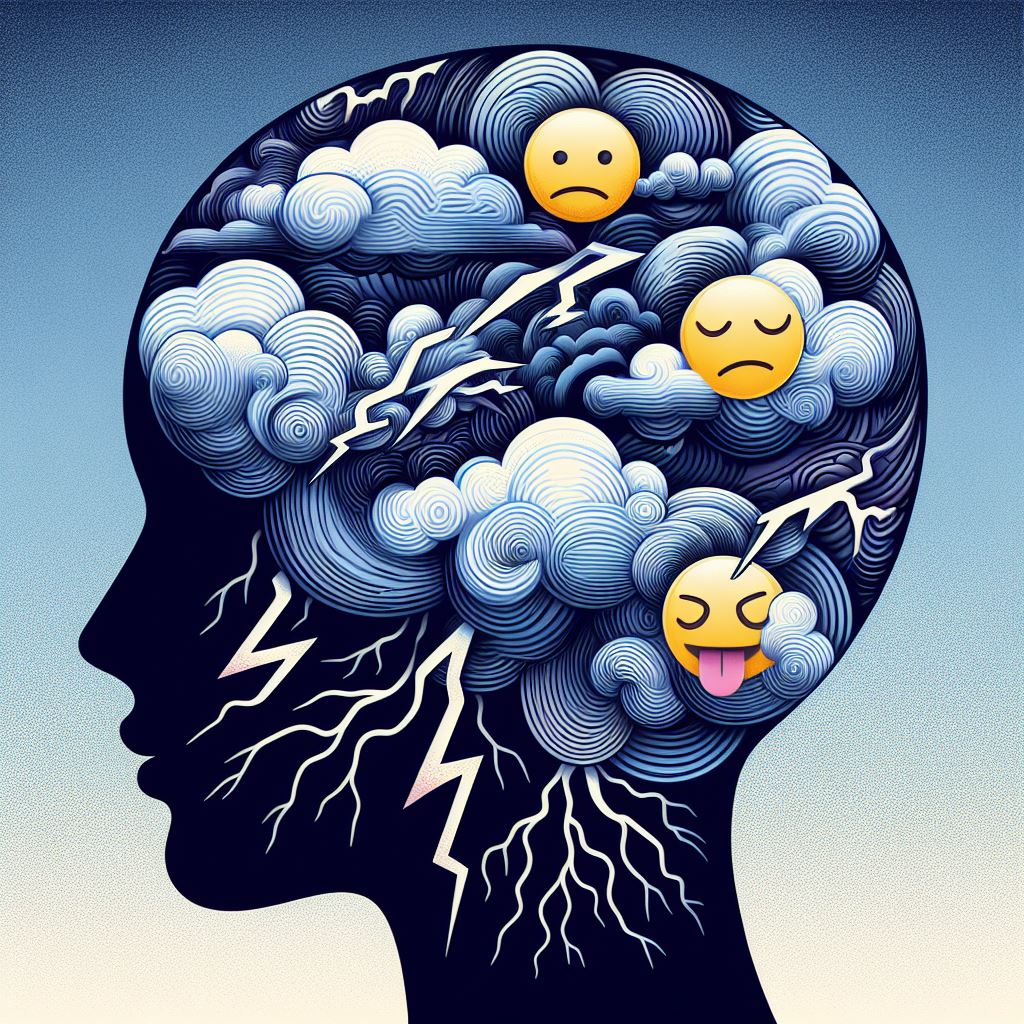Why our minds seem to navigate on autopilot with automatic thoughts, sometimes having negative automatic thoughts? Well, being the “negative thinker” is not just a random quirk – it’s a survival strategy going wrong sometimes.
Back in our ancestral days, our predecessors grappled with constant threats and opportunities. In the grand effort of staying alive, conserving energy became a top priority. Imagine having to focus intently on every single decision – it would be mentally draining.
The problem starts when these automatic thoughts become negative unkind to us – and the negative automatic thoughts lead to mental health problems.
Table of Contents
Four components of automatic thoughts
Negative thinking and automatic thoughts have four big components. First, they are unconscious, and we are usually not fully aware of what’s going on. Second, they are efficient, and we run them without even realising it. Third, we did not plan to think about them. Lastly, it is something we can’t quite control.
Think of it like a continuous flow, a natural part of how our minds work in the background.
What are the 4 stages of negative thinking?
Negative thinking and our “bad thoughts” unfolds through a sequence of four interconnected stages. At the core are schemas – enduring internal structures shaping how we process information and perceive the world. These mental frameworks serve as the lens through which we interpret experiences, constructing the foundation of our cognitive landscape. You can think about schemas as mostly useful, but rigid rules about the world and yourself.
Embedded within schemas are core beliefs, and convictions colouring our self-perception. For instance, one might harbour the core belief of being inherently a failure, which influences everything they do – from work to making friendships. These beliefs, often nuanced, cast a dark shadow over our thoughts and actions.
Intermediate beliefs act as bridges between schemas and core beliefs, and everyday scenarios, presenting themselves as if-then rules. These rules dictate responses to specific situations, constructing a cause-and-effect narrative. For instance, the belief that financial success equals personal success establishes a platform for conditional thinking – “if I make a lot of money, then I am successful”. The problem with these beliefs is that they are often incorrect or unachievable.
The last step is our automatic thoughts – quick and involuntary thoughts filling our minds. These immediate responses to situations stem from underlying schemas, core beliefs, and intermediate rules. For someone struggling with negative core beliefs, an automatic thought could be like “I will never be able to find a job”. We refer to these as negative automatic thoughts
What are negative automatic thoughts?
As mentioned earlier, automatic negative thoughts (ANTs) are quick and sneaky, often slipping into our minds without us even realising it. These thoughts usually target us, with phrases like “I don’t get this book; I must be dumb.” The language is extreme, making us feel not good enough and pushing us to do better. What’s interesting is that we tend to be way harder on ourselves internally than we would ever be to someone else, no matter the situation.
Sometimes these negative thoughts turn outward, criticising others as a way to protect ourselves or boost our self-esteem. For example, we might have a negative thought such as, “This person doesn’t understand the process; they shouldn’t have been promoted.” While it might seem like a valid observation, digging a bit deeper often reveals that these thoughts stem from a fear that the other person could expose our flaws. So, we attack first to avoid being vulnerable.
In the case of social anxiety disorder, these automatic negative thoughts often centre around worrying about what others think of us. These thoughts can get really detailed, like stressing over what someone might think about our hair, even if there’s nothing obviously wrong with it. This intense focus on imagined judgments shows how these automatic thoughts shape how we see ourselves and interact with the world. Understanding where these thoughts come from can be key to managing and challenging them effectively.
negative thinking examples
Automatic negative thoughts (ANTs) often manifest in specific patterns, and identifying these patterns is crucial for addressing and challenging them. Here are some common types of automatic negative thoughts along with examples:
Black-and-White Thinking
People tend to see things in extremes (all good / all bad), leaving no room for a middle ground. For instance, if their performance falls short of perfection, they may perceive themselves as complete failures. An example could be, “I didn’t get a perfect score on the test; I’m a complete failure.”
Catastrophising
Catastrophising involves exaggerating the importance of situations or events, often envisioning the worst possible outcome. People may think, for instance, that a small mistake at work is a catastrophic event with implications for their entire career. An example could be, “I made a small mistake at work; I will be fired and my entire career will be ruined.”
Disqualifying the Positive
In this pattern, people dismiss positive experiences or accomplishments, convincing themselves that these don’t matter or aren’t valid. For example, even after receiving compliments on a presentation, someone might dismiss the praise by assuming others were merely being polite. An example could be, “I received compliments on my presentation, but they probably just said that to be polite.”
Should Statements
Using words like “should” or “must” as motivators is a common pattern, often leading to feelings of guilt if expectations are not met. For instance, someone might believe they should exercise every day and feel lazy if they don’t. Another example could be directed toward others: “They shouldn’t have been promoted before me; it’s not fair.”
Recognising these automatic negative thoughts and understanding their patterns is the initial step in challenging and changing them. Developing a more balanced and realistic perspective can contribute to improved mental well-being.
What mental illness causes negative thoughts?
Negative automatic thoughts, while not exclusive indicators of mental illness, often play a significant role in various mental disorders, intensifying their impact on individuals’ well-being. These persistent thoughts commonly surface in conditions like depression, anxiety disorders, and obsessive-compulsive disorder (OCD) (we offer OCD treatment in Sydney).
In the context of depression, negative automatic thoughts are often about hopelessness and worthlessness. For example, someone might have thoughts like, “I can’t accomplish anything; I’m a burden to others,” perpetuating a cycle of despair, self-doubt, and low mood.
Within anxiety disorders, automatic negative thoughts often focus on worries and exaggerated concerns about future events. Catastrophising becomes a common theme, with individuals imagining the worst possible outcomes. For instance, someone with social anxiety might think, “If I speak up, everyone will think I’m foolish,” heightening feelings of fear and leading to avoidance of social situations.
In the complex landscape of Obsessive-Compulsive Disorder (OCD), automatic negative thoughts frequently drive compulsive behaviours. These thoughts may revolve around irrational fears or concerns, compelling individuals to perform rituals to ease their anxiety. An example might be someone with contamination fears thinking, “If I don’t wash my hands repeatedly, I’ll get sick,” leading to compulsive handwashing rituals that provide temporary relief.
How do I stop negative self-thoughts?
Putting a stop to negative self-thoughts is a gradual process that involves recognising and reshaping deeply ingrained thought patterns. As mentioned earlier, these automatic negative thoughts are just the “tip of the iceberg.” Collaborating with a psychologist to explore intermediate- and core beliefs is crucial for gaining a comprehensive understanding and transforming these well-established cognitive patterns.
The initial and admittedly challenging step is acknowledging and recognising the automatic thoughts. One practical approach is to keep a thought diary, where you document negative thoughts about yourself throughout the day. The key is to capture specifics: note where you were, what you were doing, and the thoughts that crossed your mind. Consistently recording these instances, even just once a day, reveals patterns and provides valuable insights into the triggers and contexts of negative self-thoughts.
Bringing this thought diary to your sessions with a psychologist can significantly enhance the therapeutic process. It helps your therapist to understand your thought patterns. This collaborative insight allows you and your therapist to work more efficiently in setting goals for therapy.
While the journey to counteracting negative self-thoughts is tricky, self-awareness, collaboration with a psychologist, and targeted interventions, such as cognitive-behavioural techniques, often lead to a positive change.
Please note that this blog post by Personal Psychology is not intended to provide professional advice. If you or someone you know is experiencing mental health difficulties, it is important to seek help from a qualified healthcare professional.




